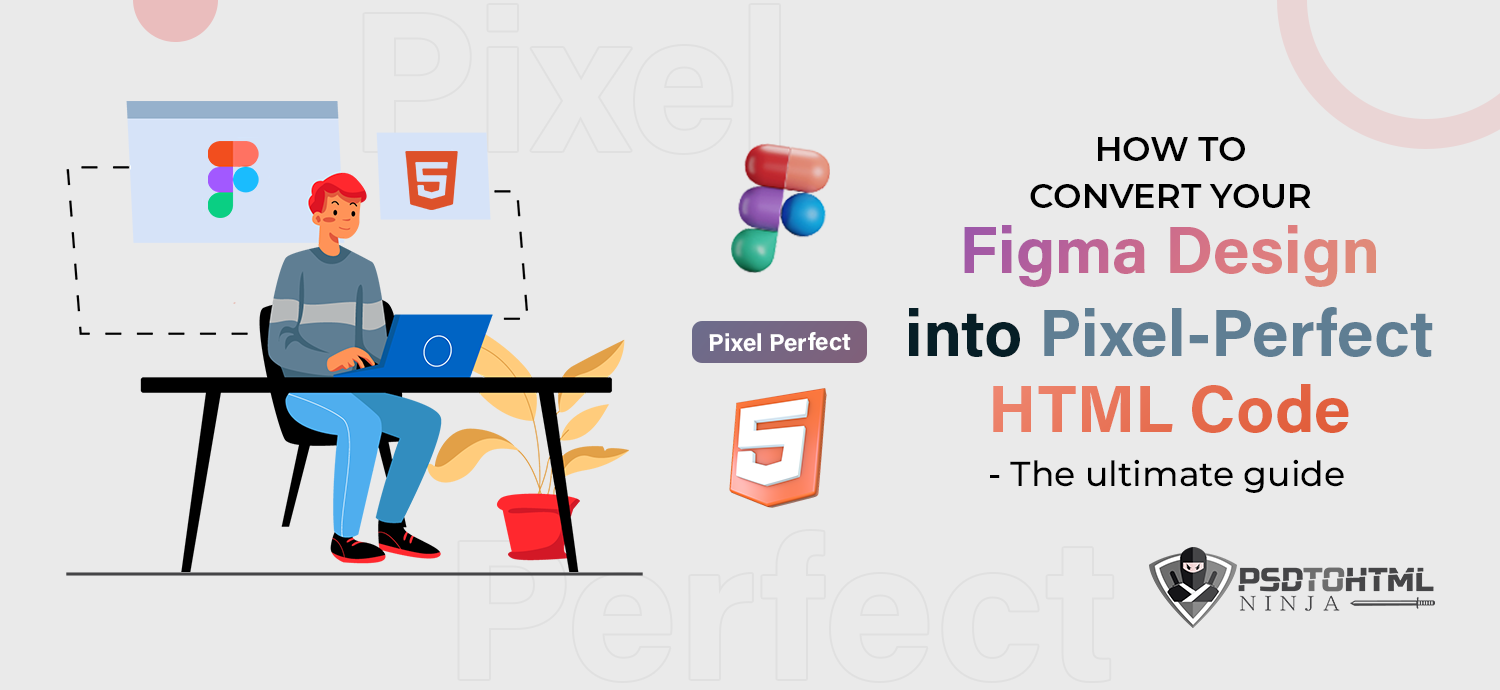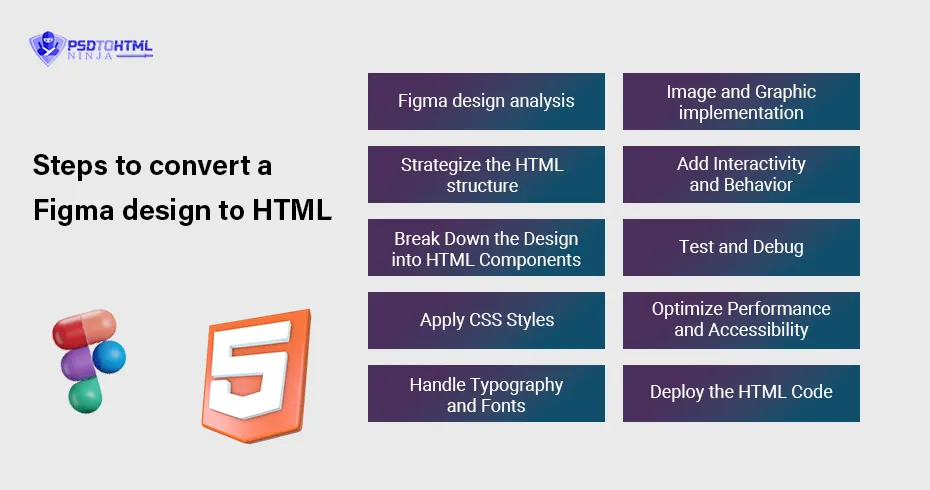How to Convert Your Figma Design into Pixel-Perfect HTML Code – The Ultimate Guide

Table of Content
Evidently, your website should be responsive, quick, and user-friendly to attract more customers and potential audiences. Reaching a wider audience is not a cakewalk, and you can easily lose them with a poorly developed website with an unattractive user interface. The human mind is creative and some people like to design their own website. But how do you convert it into a fully-functional website? That job is done with a Figma to HTML conversion service.
People often have their website designs in Figma format. You can get a website of your choice by converting Figma to HTML using pixel-perfect HTML code. Trained developers and coders can convert even the most complex Figma designs to feature-loaded websites
Why choose Figma?
Figma is the most popular graphic editing tool that works for the web. It develops the best and most creative user interface designs for websites. It is a web-based tool that helps in designing and prototyping. It also offers several features like a collaborative workspace that allows multiple designers to work simultaneously.
Another essential aspect of Figma is it is cloud-based, which makes it accessible to designers wherever they are. You can also integrate it with other tools and systems for added convenience.
What is Figma to HTML conversion?
Figma to HTML conversion process enables converting Figma designs to functioning CSS and HTML codes. The service ensures that a design of your choice is successfully transformed into a world-class website.
During the Figma to HTML conversion process, designers or developers analyze the Figma design file and manually write HTML markup that accurately represents the design. This involves identifying the different components of the design, such as headers, paragraphs, buttons, images, and more, and translating them into their corresponding HTML tags and attributes.

Steps to convert a Figma design to HTML
Below is a basic breakdown of how Figma designs are converted to HTML codes.
#1. Figma design analysis
The first step involves carefully examining and analyzing the Figma design. You should determine the various sections of the design including headers, footers, navigation menus, etc.
#2. Strategize the HTML structure
The coder determines the overall structure of the HTML code based on the design's layout and components. Later, they decide the appropriate HTML tags to use for each section, such as <header>, <nav>, <main>, <footer>, <div>, etc.
#3. Break Down the Design into HTML Components
Identify individual components within the design, such as buttons, forms, images, and text blocks and create HTML markup for each component, using the appropriate HTML tags and attributes.
#4. Apply CSS Styles
This stage involves applying the visual styles in the Figma design, including colours, typography, spacing, and effects. Write CSS code to replicate the styles, using classes, IDs, or inline styles as needed. Ensure responsiveness by applying media queries and CSS techniques to adapt the design for different screen sizes.
#5. Handle Typography and Fonts
Identify the fonts used in the Figma design and ensure they are available for web use. Use CSS to define font families, sizes, weights, and styles to match the design's typography.
#6. Image and Graphic implementation
Export and optimize images from the Figma design for web use. Insert images in the HTML markup using the <img> tag and specify appropriate attributes like alt text, dimensions, and file paths.
#7. Add Interactivity and Behavior
You should add interactive elements in the Figma design, such as buttons, links, and form fields. This also requires you to add event handling and behaviour using JavaScript or CSS animations/transitions.
#8. Test and Debug
Thoroughly test the converted HTML code in different browsers and devices to ensure consistent rendering. Validate the HTML markup using tools like the W3C Markup Validation Service to identify and fix any syntax errors or compliance issues. Test the design's responsiveness and functionality, including form submissions, links, and interactive elements.
#9. Optimize Performance and Accessibility
Optimize the HTML and CSS code for faster page loading, by minimizing file sizes, leveraging caching, and optimizing image compression. Ensure accessibility by using semantic HTML, providing alternative text for images, and adhering to accessibility guidelines.
#10. Deploy the HTML Code
Once you are satisfied with the conversion, upload the HTML files and associated assets (CSS, images, etc.) to a web server. Confirm that the design displays correctly in the browser and is accessible to users.
Also Read: Sketch to HTML Conversion: A Step-by-Step Guide {2024}

Benefits of considering PSDtoHTMLNinja for your Figma to HTML code conversion
Companies and businesses highly prefer converting Figma to HTML codes for added benefits and better results. Figma allows businesses to visualize their websites in a form of their choice. They can add their preferred features to the website and watch them come to life after a rigorous conversion process.
Figma can be used on a number of platforms and it is cloud-based, so users can access their projects anytime and anywhere. If you are thinking of creating a world-class website for your business, then Figma is the right choice.
When it comes to design-to-code conversion services, PSDtoHTMLNinja is a recognised leader in the field. Whether you want world-class PSD to WordPress conversion, PSD to HTML conversion, PSD to Shopify conversion, or Sketch to HTML conversion, etc. we can deliver the best results. Here are the major benefits of choosing Figma to HTML conversion:
#1. Optimum performance
Your website should deliver a top-notch performance for a smooth workflow. It should never get stuck, allowing all the commands and processes to run smoothly. Figma is rated high in terms of performance which enables you to add and edit designs, send updates, and prompt feedback for changes that occur.
#2. Collaborative designs
Since Figma is a cloud and web-based tool, it is easily accessible on the cloud. A team of multiple coders and developers can simultaneously work on the same project and complete it on time. Timely collaboration ensures the conversion process is efficiently completed, leaving no room for delays. Teams can also identify errors and defects easily in a collaborative environment.
#3. Design consistency
Figma simplifies maintaining design consistency throughout the project. With its shared libraries and design components, designers can create reusable design assets, ensuring consistency across multiple screens and layouts. Additionally, Figma's version control feature allows teams to track and revert changes, reducing the risk of design inconsistencies and providing a reliable history of the design's evolution.
#4. Better prototyping
Design professionals may construct interactive prototypes and replicate user interactions with the help of Figma's powerful prototyping capability. Stakeholders and clients may see the user experience and offer early feedback thanks to this capability. The cooperation between designers and developers is further made easier by Figma's seamless design-to-development handoff capabilities, which speed up the process from conception to execution.
#5. Added plugins
Apart from a variety of features you get on Figma, developers can also utilize other plugins very easily. Figma can be effortlessly integrated with third-party tools and plugins for added performance. It helps in streamlining processes and increasing productivity. Figma’s plugin feature also ensures that repetitive tasks are automated to save time and resources.
The cost associated with Figma to HTML conversion
Converting your Figma designs to HTML requires lots of resources and effort. Though it doesn't come cheap, the exact cost is fairly complex to determine. Different service providers offer different rates depending on the design format, features required, deadline, and team size.
PSDtoHTMLNinja is a known name in the Figma to HTML conversion industry and we offer the service at reasonable prices. You can contact our team for a fair price quote.
Conclusion
Convert your Figma designs to fully functional, responsive, and fast-loading websites with an industry recognised Figma to HTML conversion service. Figma has various benefits like cross-platform accessibility, plugin integration, high-quality graphics, etc. You get a resultant website that impresses your audience and gains more traffic.
Frequently Asked Questions
1. How accurate is the Figma to HTML conversion process?
The accuracy of the Figma to HTML conversion depends on several factors. It is crucial to have a thorough understanding of HTML, CSS, and the intricacies of the Figma design. Attention to detail is key, ensuring that the HTML markup and CSS styles accurately replicate the visual elements of the Figma design. By following best practices and conducting thorough testing, it is possible to achieve a high level of accuracy in the conversion process.
2. Can Figma designs be converted into responsive HTML websites?
Yes, you can convert Figma designs into responsive HTML websites. You can apply design principles during conversion to ensure that the resulting HTML code adapts to different screen sizes and devices. With CSS techniques like media queries and flexible layouts, the HTML code derived from Figma designs can deliver a consistent user experience across various devices.
3. Is Figma a free tool?
Yes, Figma is a free tool that helps developers work on a variety of designs to create seamless user designs.
4. Can Figma generate HTML and CSS?
No, Figma can’t directly generate HTML and CSS. However, you can always use the Figma to HTML and CSS plugin for this task.
 Emma Smith
Emma Smith 